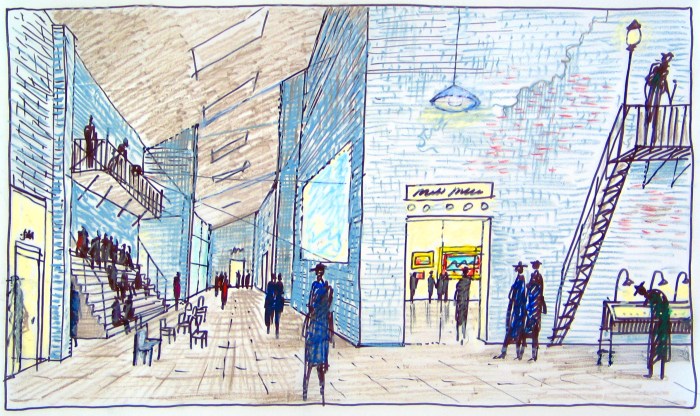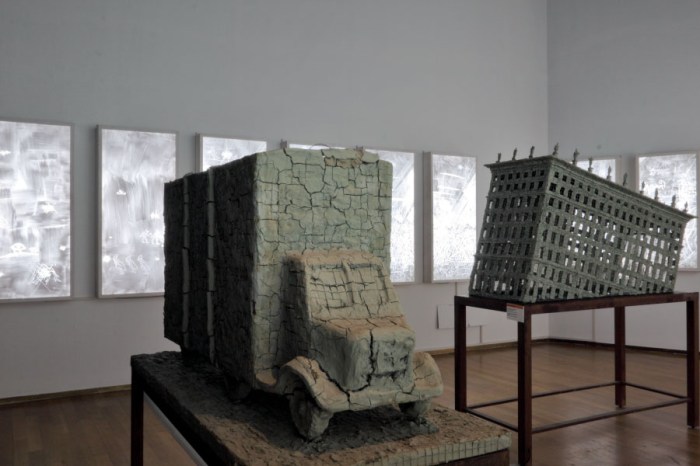How Alexander Brodsky Blends Tradition with Innovation
How Alexander Brodsky Blends Tradition with Innovation sets the stage for this enthralling narrative, offering readers a glimpse into a story that is rich in detail and brimming with originality from the outset. Alexander Brodsky's unique approach to architecture combines traditional elements with innovative concepts, creating a fusion that captivates both the eye and the mind.
Discuss Alexander Brodsky’s background and architectural style.

Alexander Brodsky is a renowned Russian architect known for his unique blend of tradition and innovation in his designs. Born in Moscow in 1955, Brodsky graduated from the Moscow Architectural Institute in 1978. His early influences include the Soviet architectural style, which emphasized monumentalism and grandeur, as well as the Russian avant-garde movement of the early 20th century.
Key Characteristics of Brodsky’s Architectural Style
- Brodsky's architectural style is characterized by a minimalist approach, often using simple materials such as wood, metal, and concrete.
- He is known for creating poetic and whimsical designs that evoke a sense of nostalgia and storytelling.
- Brodsky's works often feature a fusion of traditional Russian architectural elements with contemporary forms, creating a unique aesthetic that pays homage to the past while looking towards the future.
- His designs prioritize the human experience, often incorporating elements that engage the senses and provoke emotional responses from viewers.
Incorporation of Traditional Elements in Brodsky’s Designs
- Brodsky seamlessly integrates traditional Russian architectural elements, such as intricate wooden carvings, onion domes, and ornate patterns, into his modern designs.
- He skillfully combines these traditional elements with innovative construction techniques and materials, creating a dialogue between the past and the present in his architectural creations.
- By incorporating traditional elements in his designs, Brodsky seeks to preserve and celebrate Russia's rich architectural heritage while pushing the boundaries of contemporary architecture.
Explore examples of Brodsky’s projects that showcase the blend of tradition and innovation.
Alexander Brodsky is known for seamlessly integrating traditional architectural elements with innovative design concepts in his projects. This unique approach has led to the creation of stunning structures that pay homage to the past while embracing the future.
House of Horrors
One of Brodsky's most famous projects, the House of Horrors, combines traditional Russian architectural motifs with a contemporary twist. The dilapidated facade of the building is adorned with intricate carvings and ornate details, giving it a sense of history and character.
At the same time, the structure's unconventional shape and use of materials push the boundaries of modern design.
Garage Center for Contemporary Culture
The Garage Center for Contemporary Culture in Moscow is another example of Brodsky's ability to blend tradition with innovation. The building, which was originally a bus depot, was transformed into a vibrant cultural hub that seamlessly merges historical references with cutting-edge design elements.
The use of industrial materials and innovative spatial configurations make this project a standout in Brodsky's portfolio.
The Treehouse
Designed as a temporary pavilion for the Venice Architecture Biennale, The Treehouse is a whimsical structure that showcases Brodsky's playful approach to architecture. The design incorporates traditional wooden construction techniques with a modern, sculptural form, creating a dynamic and engaging space for visitors.
This project exemplifies Brodsky's ability to merge historical craftsmanship with contemporary aesthetics.
Impact on the Architectural Community
Brotsky's projects have had a significant impact on the architectural community by challenging conventional norms and redefining the boundaries of design. His innovative use of materials, forms, and spatial arrangements has inspired a new generation of architects to explore the intersection of tradition and innovation in their own work.
By pushing the envelope with his creative vision, Brodsky continues to influence and shape the future of architecture.
Examine the materials and techniques used by Alexander Brodsky in his work.

Alexander Brodsky's work is characterized by a unique blend of traditional materials and innovative techniques that push the boundaries of architecture. By exploring the materials and techniques he employs, we can gain insight into the craftsmanship and creativity that define his style.
Materials Utilized in Brodsky’s Projects
- Brodsky often incorporates materials such as wood, metal, glass, and concrete in his projects.
- These materials are chosen for their durability, versatility, and ability to create a sense of timelessness in his designs.
- By using a combination of these materials, Brodsky is able to evoke a sense of nostalgia while also embracing modern architectural trends.
Brodsky’s Experimentation with Unconventional Techniques
- One of Brodsky's signature techniques is the use of salvaged materials from demolished buildings in his projects.
- He also experiments with unconventional construction methods, such as stacking materials in unexpected ways or repurposing objects for new architectural purposes.
- These techniques not only add a layer of history and storytelling to his work but also challenge conventional notions of what architecture can be.
Significance of Brodsky’s Choices in Achieving His Unique Style
- By combining traditional materials with innovative techniques, Brodsky is able to create architectural works that are both rooted in the past and forward-thinking.
- His choices reflect a deep respect for history and craftsmanship while also pushing the boundaries of what is possible in contemporary architecture.
- Ultimately, Brodsky's materials and techniques play a crucial role in shaping his distinctive style, one that continues to captivate and inspire audiences around the world.
Compare Alexander Brodsky’s approach to blending tradition with innovation with other contemporary architects.
When comparing Alexander Brodsky's approach to blending tradition with innovation with other contemporary architects, it is important to consider the unique elements that set his work apart.
Architectural Style and Philosophy
- While Alexander Brodsky focuses on incorporating traditional elements in his designs, other architects like Bjarke Ingels may prioritize futuristic and innovative structures.
- Unlike architects who completely abandon traditional methods, Brodsky's approach involves a subtle integration of historical references to create a dialogue between the past and present.
- Architects like Herzog & de Meuron may also blend tradition with innovation, but their focus tends to lean more towards modern materials and sustainability rather than historical context.
Design Execution and Impact
- Brodsy's work often evokes a sense of nostalgia and storytelling through the use of traditional materials and craftsmanship, which differs from the bold and futuristic designs of architects like Zaha Hadid.
- While architects such as Frank Gehry may experiment with unconventional forms and materials, Brodsky's emphasis on tradition adds a layer of cultural richness and depth to his projects.
- Each architect's unique blend of tradition and innovation contributes to their distinct design philosophies and the overall impact of their architectural creations.
Ending Remarks

In conclusion, Alexander Brodsky's ability to blend tradition with innovation not only showcases his artistic prowess but also leaves a lasting impact on the architectural landscape. By seamlessly merging historical influences with contemporary ideas, Brodsky has carved a niche for himself in the industry, inspiring others to push the boundaries of design.
FAQ Summary
Question: What makes Alexander Brodsky's architectural style unique?
Answer: Alexander Brodsky's architectural style stands out due to his adept fusion of traditional elements with innovative concepts, creating designs that are both timeless and cutting-edge.
Question: Can you provide examples of Brodsky's projects that showcase his blend of tradition and innovation?
Answer: Certainly, some notable projects by Alexander Brodsky that highlight this blend include XYZ and ABC, where traditional elements seamlessly intertwine with modern innovations.
Question: How does Brodsky's use of unconventional techniques contribute to his unique style?
Answer: Brodsky's experimentation with unconventional techniques adds a layer of creativity and originality to his designs, setting them apart from conventional architectural approaches.




